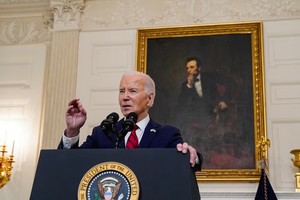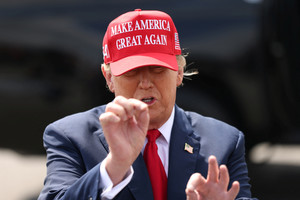When No One Notices the President

Throughout the 2020 campaign, Joe Biden frequently described himself as a “transitional president”. Part of the reasoning for his use of this language was to reassure younger voters that they should not see him as an obstacle to their generational goals. But Biden was also attempting to not only differentiate himself from Donald Trump ideologically but to present himself as Trump’s dispositional opposite as well.
Biden talked about a return to normalcy and promised to be a less disruptive and combative presence in the lives of the American people. More specifically, he told us that we would not have to see him on television every night. For an electorate exhausted by years of Trump melodrama, this sounded like a welcome reprieve.
But for better or worse, an essential part of the modern presidency is the bully pulpit. In an era before the advent of electronic media, political leaders could concentrate on the substantive requirements of their jobs. But each newly developed form of communications technology has made our leaders that much more accessible to us, and we have become accustomed to more direct exposure to them.
Just as Franklin Roosevelt became skilled at the use of radio to reassure the voters through an economic depression and world war, and John Kennedy and Ronald Reagan mastered television to develop the facsimile of a personal connection with their supporters, Donald Trump was the first American politician whose social media skills allowed him to build a direct relationship with his most fervent loyalists.
But Trump’s ubiquitous presence was so relentless that Biden and his advisors decided that he would benefit from a lower media profile. The current president has held fewer news conferences, conducted fewer interviews, and generally been a smaller presence in the lives of voters than most of his recent predecessors. But as a result, most Americans know less about him and the work of his administration. This has been a source of continuing frustration for Biden’s advisors, who have watched as voters give him little credit for the country’s economic progress. And last week, the president’s behind-the-scenes work in response to the tragic Hawaiian wildfires led to widespread criticism that he was not doing enough to help the residents of the island as they struggled with the aftermath of the catastrophe.
Biden’s lack of media engagement is not just a matter of atypical presidential modesty. He is now 80 years old, and most octogenarians have lost a step or two or more as they age. While Biden has always had a propensity for misstatements throughout his political career, even his strongest supporters admit that he frequently struggles to communicate in a way that was simply not the case when he was younger.
But in addition to his propensity for gaffes, Biden and his team clearly do believe that Americans prefer their politicians not to be a constant presence in their lives. The problem is that the less Biden talks to voters, the less they hear and the less they know. If they are less aware of the work that their president is doing, they are less likely to support him. Which, for an incumbent who appears to be facing a particularly close and hard-fought re-election campaign next year, is a considerable problem.
Biden and his wife did travel to Hawaii on Monday, but it appeared to be in reaction to criticism for his absence as much as a proactive desire to be on the scene. While Trump was given markedly poor reviews for his visit to Puerto Rico in the aftermath of Hurricane Fiona several years ago, Biden has extensive experience in this role. For a president who is renowned for his ability to convincingly demonstrate compassion to those suffering from personal loss, going to Maui would have seemed like a natural – and valuable – opportunity.
Some of this information gap can be filled through paid advertising (the Biden campaign announced major advertising over the weekend to sell his record on economic issues). But in presidential campaigns, news media coverage has a much greater impact than paid television or digital ads. Between now and next November, the president and his advisors will have to decide whether the benefits of additional publicity outweigh the risk.
Want to talk about this topic more? Join Dan for his webinar "Politics In The Time of Coronavirus." Or read more of Dan’s writing at: www.danschnurpolitics.com.
Dan Schnur is a Professor at the University of California – Berkeley, Pepperdine University, and the University of Southern California, where he teaches courses in politics, communications and leadership. Dan is a No Party Preference voter, but previously worked on four presidential and three gubernatorial campaigns, serving as the national Director of Communications for the 2000 presidential campaign of U.S. Senator John McCain and the chief media spokesman for California Governor Pete Wilson. He has a Center bias.
This piece was reviewed and edited by Isaiah Anthony, Deputy Blog Editor (Center bias).

May 1st, 2024

May 1st, 2024

April 29th, 2024

April 29th, 2024